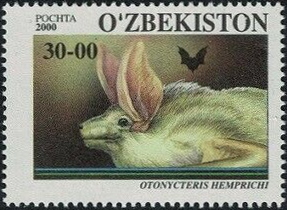Desert long-eared bat facts for kids
Quick facts for kids Desert long-eared bat |
|
|---|---|
 |
|
| Conservation status | |
| Scientific classification | |
| Genus: |
Otonycteris
|
| Species: |
hemprichii
|
The desert long-eared bat (Otonycteris hemprichii) is a cool type of bat. It lives in dry, hot places like North Africa and the Middle East. These bats are known for their super long ears!
Contents
About Desert Long-Eared Bats
Scientists are still figuring out the exact family tree of the Otonycteris bats. But by looking at their chromosomes (tiny parts inside their cells), they think these bats are related to other bat groups like Barbastella and Plecotus.
What Do Desert Long-Eared Bats Look Like?
These bats are quite small. Their body and head together are about 7 to 8 centimeters (about 3 inches) long. Their forearms, which are part of their wings, are about 5.7 to 6.7 centimeters long. Their tails can be 4.7 to 7 centimeters long.
Male bats usually weigh around 18 to 20 grams. That's about the weight of a few paper clips!
Their Amazing Ears
The desert long-eared bat has very special ears. They are almost horizontal and connect across their forehead with a band of skin. These ears can be as long as 4 centimeters (about 1.5 inches)!
Color and Other Features
Their fur is usually a pale sandy color or dark brown on top. Their belly is whitish. Their skull and teeth are similar to another type of bat called Eptesicus.
Interestingly, some female desert long-eared bats have two sets of mammae (milk glands). This is quite unusual for mammals. Scientists are not sure if both sets are used for feeding their young.
Where Do Desert Long-Eared Bats Live?
These bats love dry, rocky, and empty areas. They have been found living in cracks in hills, like in the Negev Desert. Sometimes, they even make their homes in buildings.
How They Fly
Desert long-eared bats have a unique way of flying. Their flight is described as "floppy and slow." This type of flight helps them hunt for food close to the ground.
What Do Desert Long-Eared Bats Eat?
These bats are carnivores, meaning they eat meat. They likely hunt close to the ground. They use echolocation (sending out sounds and listening for echoes) to find large flying insects or creatures walking on the ground.
Hunting Scorpions
Desert long-eared bats are famous for eating scorpions! They can detect scorpions just by the sound of them walking. They mostly eat arachnids (like spiders and scorpions) and orthopterans (like crickets and grasshoppers).
An interesting study in Israel found that up to 70% of bat droppings contained scorpion parts. This included pieces of the very venomous Palestine yellow scorpion. The bat catches the scorpion and bites off its head.
Even though scorpions can sting, these bats are often stung in the face. But they show no signs of being harmed by the venom. This suggests that desert long-eared bats are somehow immune to scorpion venom!
Bat Families and Babies

Female desert long-eared bats form special groups called breeding colonies. These groups can have anywhere from 3 to 15 females.
Scientists have found pregnant females in different places. For example, seven pregnant females, most carrying two embryos (baby bats), were found in central Asia. In an old hut in Jordan, three pregnant females were found, and all of them were also carrying two embryos.
Where Can You Find Desert Long-Eared Bats?
These bats live across a wide area. Their range includes countries like Afghanistan, Algeria, Egypt, India, Iran, Israel, Jordan, Kazakhstan, Libya, Morocco, Niger, Oman, Pakistan, Palestine, Qatar, Saudi Arabia, Sudan, Syrian Arab Republic, Tajikistan, Tunisia, Turkey, Turkmenistan, United Arab Emirates, and Uzbekistan.


